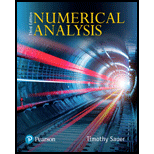
Numerical Analysis
3rd Edition
ISBN: 9780134696454
Author: Sauer, Tim
Publisher: Pearson,
expand_more
expand_more
format_list_bulleted
Concept explainers
Textbook Question
Chapter 9.1, Problem 1E
Find the period of the linear congruential generator defined by (a)
(b)
Expert Solution & Answer
Want to see the full answer?
Check out a sample textbook solution
Students have asked these similar questions
Theorem 2.4 (The Hölder inequality)
Let p+q=1. If E|X|P < ∞ and E|Y| < ∞, then
.
EXY SEXY ≤ Xp Yq.
1 for all k, and set o
(ii) Let X1, X2,
that P(Xkb) =
x > 0.
Xn be independent random variables with mean 0, suppose
=
and
Var Xk. Then, for
0x) ≤2 exp-tx+121
Στ
k=1
Lemma 1.1 Suppose that g is a non-negative, non-decreasing function such that
E g(X) 0. Then,
E g(|X|)
P(|X|> x) ≤
g(x)
Chapter 9 Solutions
Numerical Analysis
Ch. 9.1 - Find the period of the linear congruential...Ch. 9.1 - Find the period of the LCG defined by a=4,b=0,m=9...Ch. 9.1 - Approximate the area under the curve y=x2 for 0x1,...Ch. 9.1 - Approximate the area under the curve y=1x for 0x1,...Ch. 9.1 - Prob. 5ECh. 9.1 - Prove that u1=x21+x22 in the Box-Muller Rejection...Ch. 9.1 - Implement the Minimal Standard random number...Ch. 9.1 - Implement randu and find the Monte Carlo...Ch. 9.1 - (a) Using calculus, find the area bounded by the...Ch. 9.1 - Carry out the steps of Computer Problem 3 for the...
Ch. 9.1 - Use n=104 pseudo-random points to estimate the...Ch. 9.1 - Use n=104 pseudo-random points to estimate the...Ch. 9.1 - (a) Use calculus to evaluate the integral 01x2x,...Ch. 9.1 - Prob. 8CPCh. 9.1 - Prob. 9CPCh. 9.1 - Devise a Monte Carlo approximation problem that...Ch. 9.2 - Prob. 1CPCh. 9.2 - Prob. 2CPCh. 9.2 - Prob. 3CPCh. 9.2 - Prob. 4CPCh. 9.2 - Prob. 5CPCh. 9.2 - One of the best-known Monte Carlo problems is the...Ch. 9.2 - Prob. 7CPCh. 9.2 - Prob. 8CPCh. 9.2 - Prob. 9CPCh. 9.3 - Design a Monte Carlo simulation to estimate the...Ch. 9.3 - Calculate the mean escape time for the random...Ch. 9.3 - In a biased random walk, the probability of going...Ch. 9.3 - Prob. 4CPCh. 9.3 - Design a Monte Carlo simulation to estimate the...Ch. 9.3 - Calculate the mean escape time for Brownian motion...Ch. 9.3 - Prob. 7CPCh. 9.4 - Use Itos formula to show that the solutions of the...Ch. 9.4 - Use Itos formula to show that the solutions of the...Ch. 9.4 - Use Itos formula to show that the solutions of the...Ch. 9.4 - Prob. 4ECh. 9.4 - Prob. 5ECh. 9.4 - Prob. 6ECh. 9.4 - Use the Euler-Maruyama Method to find approximate...Ch. 9.4 - Use the Euler-Maruyama Method to find approximate...Ch. 9.4 - Apply the Euler-Maruyama Method with step size...Ch. 9.4 - Prob. 4CPCh. 9.4 - Prob. 5CPCh. 9.4 - Prob. 6CPCh. 9.4 - Use the Milstein Method to find approximate...Ch. 9.4 - Prob. 8CPCh. 9.4 - Prob. 9CPCh. 9.4 - Prob. 10CPCh. 9.4 - Prob. 11CPCh. 9.4 - Prob. 12CPCh. 9.4 - Prob. 1SACh. 9.4 - Prob. 2SACh. 9.4 - Prob. 3SACh. 9.4 - Prob. 4SACh. 9.4 - Compare your approximation in step 4 with the...Ch. 9.4 - Prob. 6SA
Knowledge Booster
Learn more about
Need a deep-dive on the concept behind this application? Look no further. Learn more about this topic, subject and related others by exploring similar questions and additional content below.Similar questions
- Proof of this Theorem Theorem 1.2 (i) Suppose that P(|X| ≤ b) = 1 for some b > 0, that E X = 0, and set Var X = o². Then, for 0 0, P(X > x) ≤ e−1x+1²², P(|X|> x) ≤ 2e−x+1² 0²arrow_forwardState and prove the Morton's inequality Theorem 1.1 (Markov's inequality) Suppose that E|X|" 0, and let x > 0. Then, E|X|" P(|X|> x) ≤ x"arrow_forward(iii) If, in addition, X1, X2, ... Xn are identically distributed, then P(S|>x) ≤2 exp{-tx+nt²o}}.arrow_forward
- 5. State space models Consider the model T₁ = Tt−1 + €t S₁ = 0.8S-4+ Nt Y₁ = T₁ + S₁ + V₂ where (+) Y₁,..., Y. ~ WN(0,σ²), nt ~ WN(0,σ2), and (V) ~ WN(0,0). We observe data a. Write the model in the standard (matrix) form of a linear Gaussian state space model. b. Does lim+++∞ Var (St - St|n) exist? If so, what is its value? c. Does lim∞ Var(T₁ — Ît\n) exist? If so, what is its value?arrow_forward2 P(x,y). kx²y X: 1,2 5.11273 Find k Find P(x/y) ③ Mxy Ng q oxy วarrow_forward> > > we are hiring Salesforce Admin Location: Remote Key Responsibilities: Administer Salesforce Sales & Revenue Cloud (CPQ & Billing) Configure workflows, validation rules & dashboards Automate processes using Flows & Process Builder Collaborate with Sales, Finance & Marketing teams Manage user roles & security Apply: Hr@forcecraver.comarrow_forward
- 3:59 m s ☑ D'Aniello Boutique | Fashion VOLTE danielloboutique.it/asia SUBSCRIBE NOW: 10% OFF TO USE ANYTIME YOU WANT d'aniello NEW IN WOMEN NEW IN MEN WINTER SALE: 50% OFF on FW24 SHOP WOMEN SHOP MENarrow_forwardJOB UPDATE EMERSON GRAD ENGINEER (FRESHERS) SOFTWARE ENGG NEW RELIC BROWSERSTACK (FRESHERS) SOFTWARE ENGG FULL STACK DATA ENGINEER GENPACT + PYTHON CARS24 WORK FROM HOME #vinkjobs TELE PERFORMANCE Vinkjobs.com CUSTOMER SUPPORT Search "Vinkjobs.com" on Googlearrow_forwardB\ Prove that if T is a spanning tree of G which contains e, then Te Is a spanning tree of G * e.arrow_forward
arrow_back_ios
SEE MORE QUESTIONS
arrow_forward_ios
Recommended textbooks for you
- Algebra & Trigonometry with Analytic GeometryAlgebraISBN:9781133382119Author:SwokowskiPublisher:Cengage
 Linear Algebra: A Modern IntroductionAlgebraISBN:9781285463247Author:David PoolePublisher:Cengage Learning
Linear Algebra: A Modern IntroductionAlgebraISBN:9781285463247Author:David PoolePublisher:Cengage Learning

Algebra & Trigonometry with Analytic Geometry
Algebra
ISBN:9781133382119
Author:Swokowski
Publisher:Cengage

Linear Algebra: A Modern Introduction
Algebra
ISBN:9781285463247
Author:David Poole
Publisher:Cengage Learning
What is a Function? Business Mathematics and Statistics; Author: Edmerls;https://www.youtube.com/watch?v=fcGNFyqRzuI;License: Standard YouTube License, CC-BY
FUNCTIONS CONCEPTS FOR CBSE/ISC/JEE/NDA/CET/BANKING/GRE/MBA/COMEDK; Author: Neha Agrawal Mathematically Inclined;https://www.youtube.com/watch?v=hhbYynJwBqk;License: Standard YouTube License, CC-BY